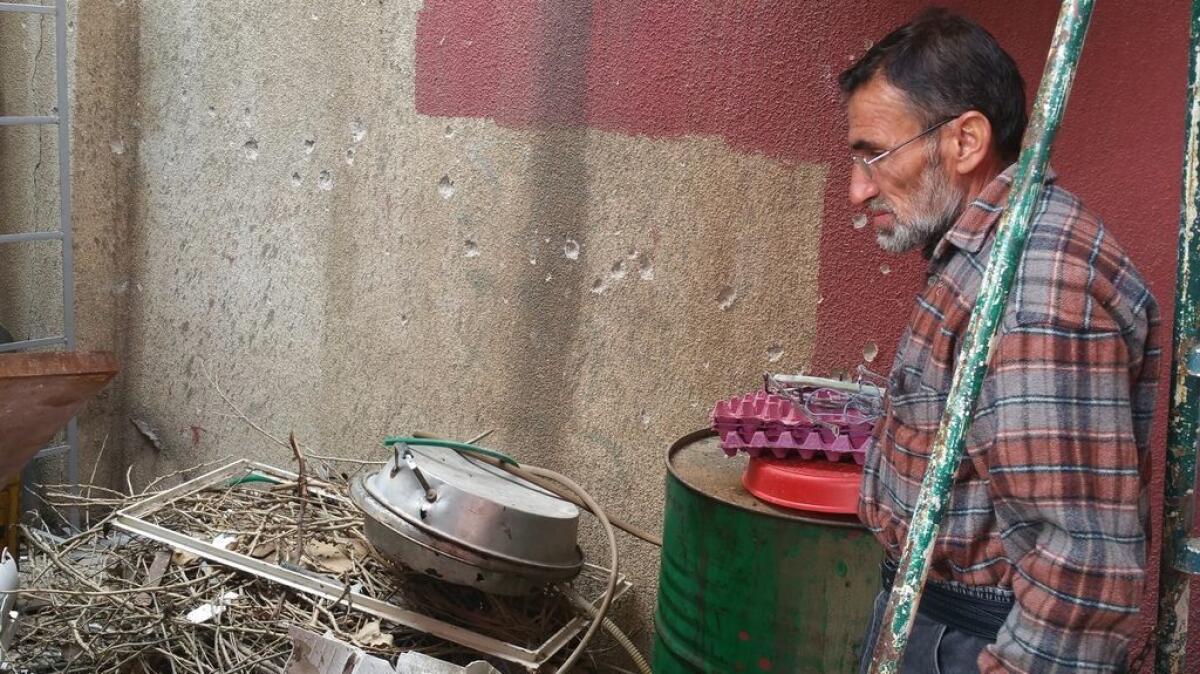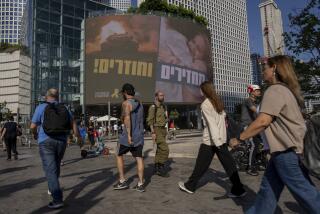In the half of Mosul freed from Islamic State, life returns to not-quite normal

First person: Los Angeles Times correspondent Nabih Bulos, view from Mosul.
Reporting from MOSUL, Iraq — In parts of this northern Iraqi city, life seems routine. People flock to sidewalk barbecue joints and falafel stands. Shops are open. Traffic snakes through run-down thoroughfares.
But war intrudes closer to the Tigris River, the line now separating government forces on the east side of the city from Islamic State jihadis bunkered in the west.
Soldiers nervously train Russian-made heavy machine guns skyward in a hunt for weaponized drones or compulsively squint at the thickets along the riverbank, firing at any sign of movement. Fearing Islamic State snipers, weary residents scurry through open spaces and past makeshift barriers meant to stop car bombs.
“Residents and security forces — we’re all a target here,” said an intelligence officer with the Iraqi army’s 16th Brigade in the Zeraai neighborhood, less than a mile from the Tigris.
In 2014, Islamic State militants seized Mosul, the second-largest city in Iraq, in a prelude to a rampage that saw the group proclaim a caliphate over wide swaths of Iraq and Syria. Mosul became its de facto capital.
The Iraqi government and the U.S.-led coalition supporting it launched an offensive last fall to take back the city and after nearly 100 grueling days of fighting regained control of the eastern half. Troops were so drained that they had to pause and regroup before resuming the the next phase of the battle: recapturing the west.
“This delay in operations came like a disease for us,” said the intelligence officer, who identified himself as Abu Ali Mutassem. “Security forces had momentum. They should have continued.”
He said that drones had dropped grenades in the Zeraai neighborhood Thursday morning and that more attacks were imminent. He urged men passing by to move under an awning for cover.
“We don’t deliver assistance to residents here by day,” he explained. “It’s too dangerous.”

Alaa Siddiq, a slight, 50-year-old government employee living in a house near Mosul’s Grand Mosque, pointed into his neighbor’s garden, where a drone had deposited a grenade that destroyed a shed and washing machine and left shrapnel gashes on the surrounding fences and trees.
“I don’t have enough money to move from here,” he said. “We just have to accept it.”
The five bridges that once spanned the Tigris in Mosul are now destroyed, taken out by coalition aircraft to make it more difficult for Islamic State militants to cross back to the east for suicide attacks. But some eastern neighborhoods still face danger from car bombs that jihadis hid there.
Mutassem said one militant tried to drive a sedan filled with explosives from Zeraai to a market, then tried to flee on foot when the car got stuck on an embankment.
“This man is not from the neighborhood. He’s a stranger,” a resident warned security forces, according to Mutassem. When the man ignored guards shouting at him to stop, they shot him.
Only then did they realize that the man was wearing a belt of explosives, which were set off. The man was killed instantly, his blood staining a wall.
The security situation has forced the United Nations to halt aid deliveries in some neighborhoods of the eastern side, where roughly 46,000 people have returned since Islamic State was driven out.
“Until security improves, it will be difficult for us to provide assistance,” Lise Grande, the U.N.’s humanitarian coordinator in Iraq, said Wednesday during a tour of a camp for those displaced from Mosul, according to the Associated Press.
Certain neighborhoods remained so dangerous that some families had decided to go back to camps for the displaced, joining the almost 154,000 people who remained behind, she said.
Humanitarian assistance is crucial. Though Mosul has largely been spared the devastation seen in the fight for the city of Ramadi and other Islamic State bastions, electricity and water grids suffered major damage in the fighting.
“We’re digging wells up to 36 feet deep to get water, but we can’t use it for drinking,” Abdullah Saleh, a 27-year-old laborer, said over the hum of generators in the neighborhood of Baysan, where the army had been distributing bottled water.
On the main highway, in front of the sprawling Remah palace built by Saddam Hussein and reportedly used by Islamic State as a training center, workers raced to stop one of four water-line breaks.
The eastern outskirts of Mosul are a much different scene, one that offers residents some hope. Food is trucked in from the city of Irbil, about 40 miles to the east, and although merchants face a gantlet of checkpoints along the route, their markets are well stocked.
Islamic State “branding” — signs, banners, graffiti and other propaganda — is being scrubbed away or torn down. A billboard that says “Our Islamic Caliphate” sits half-ripped atop a building. Nearby are the burned tatters of an Islamic State flag.
Near the Remah palace, government authorities missed a large-scale mural of a militant raising a knife to the Colosseum in Italy and vowing “to conquer Rome,” a threat often repeated by the group’s leaders.
Even with the dangers still present, residents said they were happy to no longer live under the rule of Islamic State, which punishes violations of its harsh code with floggings, amputations and beheadings.
“Despite everything, the drones, whatever … this is like heaven for us compared to how it was,” said Abeer Abdul Khaleq, a software engineer who had been forced to abandon her studies when the militants seized Mosul.
“I couldn’t even walk out of the house to my garden,” she said. “They told my husband one time I wasn’t dressed correctly. Damn them.”
She flinched at the sound of a large explosion, before a soldier told her it was an outgoing shell hitting west Mosul. The look of worry on her face intensified.
“My parents are there,” she said.
Bulos is a special correspondent.
More to Read
Sign up for Essential California
The most important California stories and recommendations in your inbox every morning.
You may occasionally receive promotional content from the Los Angeles Times.











